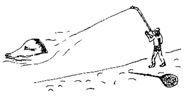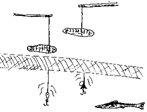Alaska Science Camps, Fairs & Experiments
ANKN is a resource for compiling and exchanging information
related to Alaska Native knowledge systems and ways of knowing. We
are pleased to create and distribute a variety of publications
that assist Native people, government agencies,
educators and the general public in gaining access to the knowledge
base that Alaska Natives have acquired through cumulative experience
over millennia.
TO ORDER THIS PUBLICATION:
Contact the ANKN
offices at 907-474-1902 or email uaf-cxcs@alaska.edu.  Fishing Fishing
with Lures
February brings longer days. People get
restless and so do the fish in many of Alaska's lakes. People chop
holes in the ice to spend hours hooking for pike, trout, shea fish,
burbot, and others.
 In
the fall people hook for grayling and shea fish through the shore
ice; during the summer we often use artificial lures to catch salmon,
pike, shea fish, grayling, and others. In
the fall people hook for grayling and shea fish through the shore
ice; during the summer we often use artificial lures to catch salmon,
pike, shea fish, grayling, and others.
Sometimes we go home with a sack of fish and other times we go
home with nothing. This poses scientific questions. Were the fish not
hungry? Did we fish in the wrong place? Did we use the wrong lure or
bait? Was our technique wrong? Did we fish too deep or too shallow?
Or are we just unlucky? Which variable influenced our lack of
success? Many people believe fishing success is greatly improved by
giving the first fish to one of the village Elders.
The First Test
There are many variables in the fishing experiment, but if we are
careful, we can control most of them. For now, lets think about
hooking through the ice in February. If we want to test a new fishing
lure, we will first have to make two holes close together. Put the
new lure on one line and an old favorite on another. If two people
fish side-by-side using the same hooking motion and fish at the same
depth, the effectiveness of the new lure should be evident.
Try it.

Variables
In doing the above we kept everything the same except the
lure. To do a truly fair scientific test, have both fishermen trade lures
back
and forth through the experiment to rule out "fisherman's luck."
Different Tests
Test whether one location is better than another by having two
people fishing with:
- the same lure at
- the same time with
- the same technique in
- different locations.

|
|
A.M.
|
P.M.
|
P.M.
|
The fishermen should swap locations several times during the test
to control the variable of luck.
 How
could you test for the time of day? How
could you test for the time of day?- How could you test for the size of the lure?
- How could you test for color? (Gold, silver, red, orange,
yellow)
- How could you test for depth of the lure?
- How could you test for technique?
More Questions
Would more valid tests be done by a larger group of people rather
than only two individuals?
Do you think that the noise the fishermen make impacts the
fishing? My wife thinks the sound of her new ice auger attracts
fish. It could be.
How could you test the sound of a person walking on the ice?
Driving a snowmachine on the ice?
Can you devise a way to observe the fish's reactions to different
lures and the sounds on the ice?
 Talk
with people who are considered "lucky" for fishing. To what do they
attribute their success? Talk
with people who are considered "lucky" for fishing. To what do they
attribute their success?
Find out what kinds of artificial lures the oldtimers used in your
region. Make one and test it against a modern one. Put a treble hook
on the traditional lure. Is the combination of modern hook and
traditional lure a good one?
What are the fish eating? Check their stomachs. Might live
bait be
more effective than a lure? What effect does "chumming" have on
fishing? (Chumming is putting oatmeal, salmon eggs, or other food in
the water. This attracts small fish that attract bigger fish.)
The Test & Results
Test the above variables, and try to determine the most favorable
conditions for fishing each type of fish in your region in different
seasons.
Keep a calender and a record of fish caught, time of day, lure or
bait used, and other variables. How do your conclusions compare with
those of the Elders in your village?
Save your conclusions for your children and grandchildren.
|